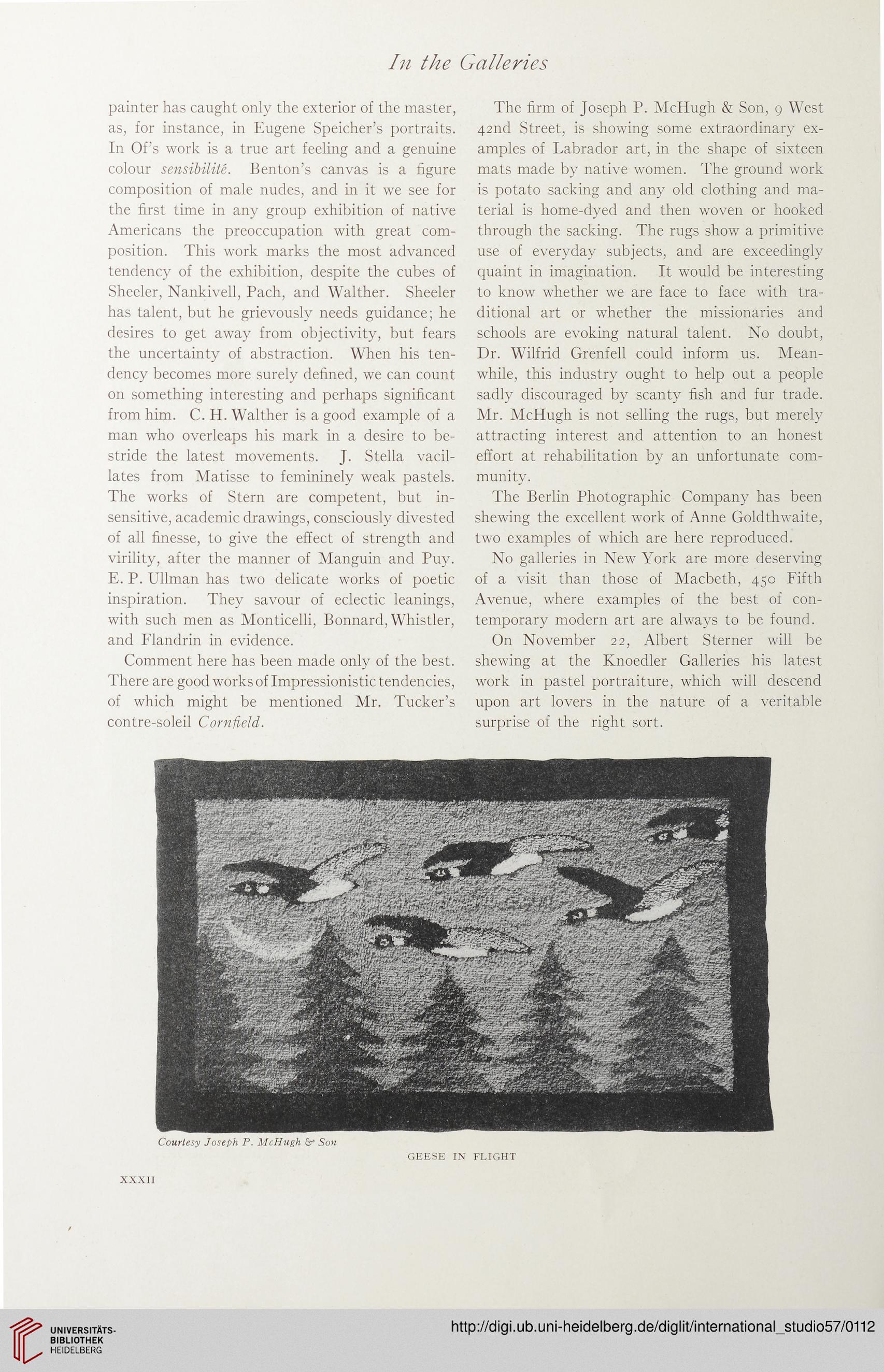In the Galleries
painter has caught only the exterior of the master,
as, for instance, in Eugene Speicher’s portraits.
In Of’s work is a true art feeling and a genuine
colour sensibilite. Benton’s canvas is a figure
composition of male nudes, and in it we see for
the first time in any group exhibition of native
Americans the preoccupation with great com-
position. This work marks the most advanced
tendency of the exhibition, despite the cubes of
Sheeler, Nankivell, Pach, and Walther. Sheeler
has talent, but he grievously needs guidance; he
desires to get away from objectivity, but fears
the uncertainty of abstraction. When his ten-
dency becomes more surely defined, we can count
on something interesting and perhaps significant
from him. C. H. Walther is a good example of a
man who overleaps his mark in a desire to be-
stride the latest movements. J. Stella vacil-
lates from Matisse to femininely weak pastels.
The works of Stern are competent, but in-
sensitive, academic drawings, consciously divested
of all finesse, to give the effect of strength and
virility, after the manner of Manguin and Puy.
E. P. Ullman has two delicate works of poetic
inspiration. They savour of eclectic leanings,
with such men as Monticelli, Bonnard, Whistler,
and Flandrin in evidence.
Comment here has been made only of the best.
There are good works of Impressionistic tendencies,
of which might be mentioned Mr. Tucker’s
contre-soleil Cornfield.
The firm of Joseph P. McHugh & Son, 9 West
42nd Street, is showing some extraordinary ex-
amples of Labrador art, in the shape of sixteen
mats made by native women. The ground work
is potato sacking and any old clothing and ma-
terial is home-dyed and then woven or hooked
through the sacking. The rugs show a primitive
use of everyday subjects, and are exceedingly
quaint in imagination. It would be interesting
to know whether we are face to face with tra-
ditional art or whether the missionaries and
schools are evoking natural talent. No doubt,
Dr. Wilfrid Grenfell could inform us. Mean-
while, this industry ought to help out a people
sadly discouraged by scanty fish and fur trade.
Mr. McHugh is not selling the rugs, but merely
attracting interest and attention to an honest
effort at rehabilitation by an unfortunate com-
munity.
The Berlin Photographic Company has been
shewing the excellent work of Anne Goldthwaite,
two examples of which are here reproduced.
No galleries in New York are more deserving
of a visit than those of Macbeth, 450 Fifth
Avenue, where examples of the best of con-
temporary modern art are always to be found.
On November 22, Albert Sterner will be
shewing at the Knoedler Galleries his latest
work in pastel portraiture, which will descend
upon art lovers in the nature of a veritable
surprise of the right sort.
Courtesy Joseph P. McHugh Son
GEESE IN FLIGHT
XXXII
painter has caught only the exterior of the master,
as, for instance, in Eugene Speicher’s portraits.
In Of’s work is a true art feeling and a genuine
colour sensibilite. Benton’s canvas is a figure
composition of male nudes, and in it we see for
the first time in any group exhibition of native
Americans the preoccupation with great com-
position. This work marks the most advanced
tendency of the exhibition, despite the cubes of
Sheeler, Nankivell, Pach, and Walther. Sheeler
has talent, but he grievously needs guidance; he
desires to get away from objectivity, but fears
the uncertainty of abstraction. When his ten-
dency becomes more surely defined, we can count
on something interesting and perhaps significant
from him. C. H. Walther is a good example of a
man who overleaps his mark in a desire to be-
stride the latest movements. J. Stella vacil-
lates from Matisse to femininely weak pastels.
The works of Stern are competent, but in-
sensitive, academic drawings, consciously divested
of all finesse, to give the effect of strength and
virility, after the manner of Manguin and Puy.
E. P. Ullman has two delicate works of poetic
inspiration. They savour of eclectic leanings,
with such men as Monticelli, Bonnard, Whistler,
and Flandrin in evidence.
Comment here has been made only of the best.
There are good works of Impressionistic tendencies,
of which might be mentioned Mr. Tucker’s
contre-soleil Cornfield.
The firm of Joseph P. McHugh & Son, 9 West
42nd Street, is showing some extraordinary ex-
amples of Labrador art, in the shape of sixteen
mats made by native women. The ground work
is potato sacking and any old clothing and ma-
terial is home-dyed and then woven or hooked
through the sacking. The rugs show a primitive
use of everyday subjects, and are exceedingly
quaint in imagination. It would be interesting
to know whether we are face to face with tra-
ditional art or whether the missionaries and
schools are evoking natural talent. No doubt,
Dr. Wilfrid Grenfell could inform us. Mean-
while, this industry ought to help out a people
sadly discouraged by scanty fish and fur trade.
Mr. McHugh is not selling the rugs, but merely
attracting interest and attention to an honest
effort at rehabilitation by an unfortunate com-
munity.
The Berlin Photographic Company has been
shewing the excellent work of Anne Goldthwaite,
two examples of which are here reproduced.
No galleries in New York are more deserving
of a visit than those of Macbeth, 450 Fifth
Avenue, where examples of the best of con-
temporary modern art are always to be found.
On November 22, Albert Sterner will be
shewing at the Knoedler Galleries his latest
work in pastel portraiture, which will descend
upon art lovers in the nature of a veritable
surprise of the right sort.
Courtesy Joseph P. McHugh Son
GEESE IN FLIGHT
XXXII




